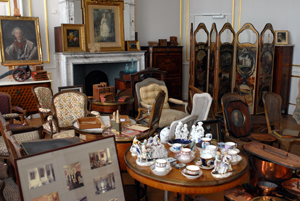Interior

One harmonious entity
Between 1761 and 1765 Giovanni Niccolò Servandoni was commissioned by Duke Charles d'Ursel to make extensive changes to the castle’s interior. Ceilings, floors, panelling, doors, alcoves, windows and cupboards in a rather sober classical style form one single decorative design. The result is an exceptionally harmonious whole, preserved almost unchanged until today.
On the ground floor, Servandoni designed spaces for social life: an entrance hall with marble floors and stucco decoration, a dining room with mirrored walls, a new library and drawing rooms with pier glasses between the windows.
In contrast to the luxurious ground floor, the first floor is more practical in purpose. There are nine ‘apartments’ for families and guests, arranged around a central corridor. The most important room in each apartment is the bedroom, which has its own fireplace, a marble mantelpiece and a large mirror.

Every bedroom has an alcove: a rectangular recess in the wall where the bed was placed. Each apartment also had two or three smaller rooms which served as wardrobes, water closets or servants’ rooms.

The taste for all things Chinese
From the end of the sixteenth century until well into the nineteenth,Chinese wallpapers were particularly popular in interior decoration. They were mainly made in the city of Canton,where there were several specialised workshops. The finished goods arrived in Western Europe via the East India Trading Companies. The discovery of new regions and foreign cultures had created a great interest in the exotic and for many years the d'Ursel family also fell under the spell of China.
Every surface of the small antechamber of the quartier de la belle alcove is decorated with Chinese wallpaper. You are completely surrounded by trees,flowering vines,birds and butterflies on a light blue background. The blue paper is typical of the 'new style' that developed in Cantonese workshops during the first quarter of the 19th century,although these wallpapers were probably not finally hung in the castle until after 1875.

A second wallpaper adorns the walls of the main drawing room and library. "The most beautiful Chinese paper I have ever seen," Countess Hedwige d'Ursel called it in about 1920. “Against a pink background immense white bamboo stalks sway while in between flit birds of many colours.
The effect is fairylike. As soon as you enter that great room, you fall under the spell of the bright pink, the white stems and the reflections of the water, all cast back at you by the mirrors.” This beautiful paper had been in the family's possession for many years,but was kept rolled up,probably until about 1900,when it was hung in the drawing room and library.
In April 2009,the castle received an important gift: four rolls of pink Chinese wallpaper,intended for the main drawing room,but never hung there. They had remained rolled up for more than 200 years,which is why the colours have been so exceptionally well-preserved.

Apart from the wallpapers, there remain some twenty separate Chinese prints. Framed in rectangular panels above doors and chimneypieces, these depict plants and animals, village and genre scenes.

Chintzes
The first chintzes were imported from India in the 16th century. Their designs of exotic plants and flowers appealed to the imagination, the fabric was finer than wool or linen and they retained their bright colours even after washing. From the 17th century onwards, with the large trading companies ensuring a permanent supply, the popularity of chintz grew and grew. Besides expensive, multi-coloured and hand-painted fabrics for the rich, the trading companies also imported printed fabrics with fewer colours aimed at the lower classes. Chintz was used for clothing, but also for bedspreads, tablecloths, furnishing fabrics, curtains and wall hangings. From the 18th century onwards, in order to meet the growing demand, cotton printing factories also began to emerge in Europe.
In fifteen rooms of the castle, the walls are covered with chintz, cotton fabrics painted or printed in India or Europe. The oldest pieces date from the middle of the 17th century and the most recent were not hung until after 1967. All together they form a unique collection: at no other castle in Europe is more chintz to be found than at Hingene.

When the Province of Antwerp bought the castle in 1994, the wall coverings were only saved at the last minute. Then while the castle was gradually being restored they were kept in various depots. Before the chintzes could be put back in place they were cleaned and disinfected as much as possible. An image processor reconstructed any missing pieces and made digital prints. A textile restorer sewed the new pieces into the old fabrics, meticulously repaired tears and holes and provided all panels with protective gauze. In some rooms, the original wall coverings were too badly damaged and a complete digital reproduction was made in the fresh, original colours.

The Duke's collection
When Duke Henri d'Ursel sold the castle in 1973, the contents were not included in the sale. More than thirty years later, however, in 2009, part of the collection unexpectedly returned to Hingene when Stéphane, the current Duke d'Ursel and grandson of Henri, decided to emigrate to Central America with his family. Before his departure he gave thousands of books, paintings, furniture and decorative art objects to the castle on long-term loan.
